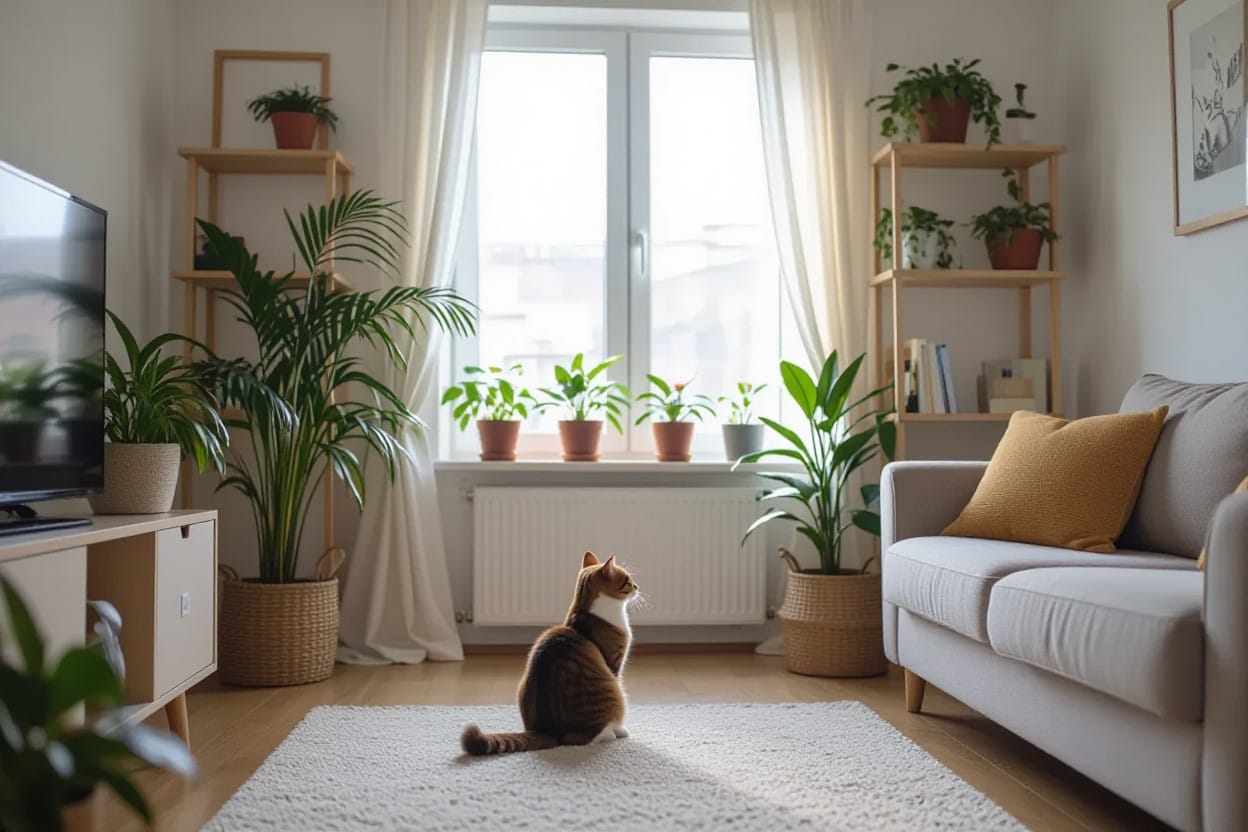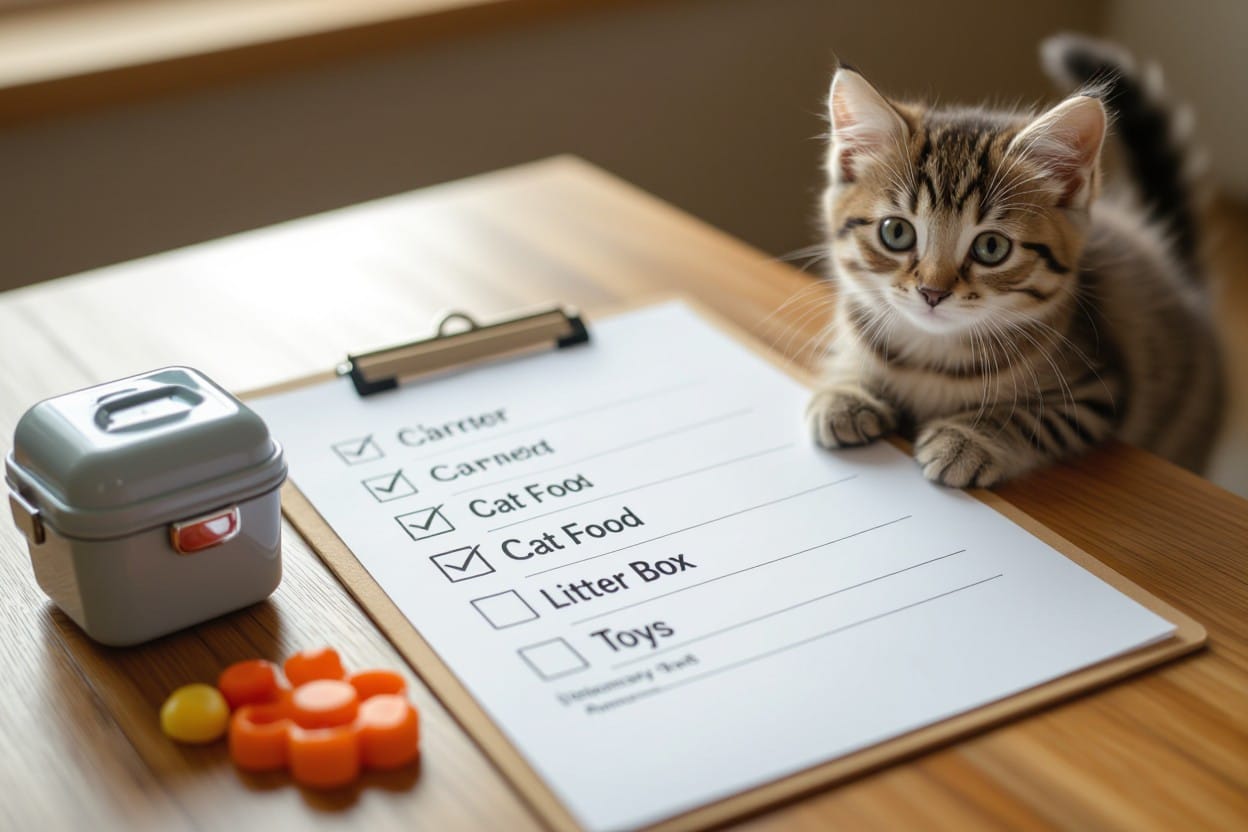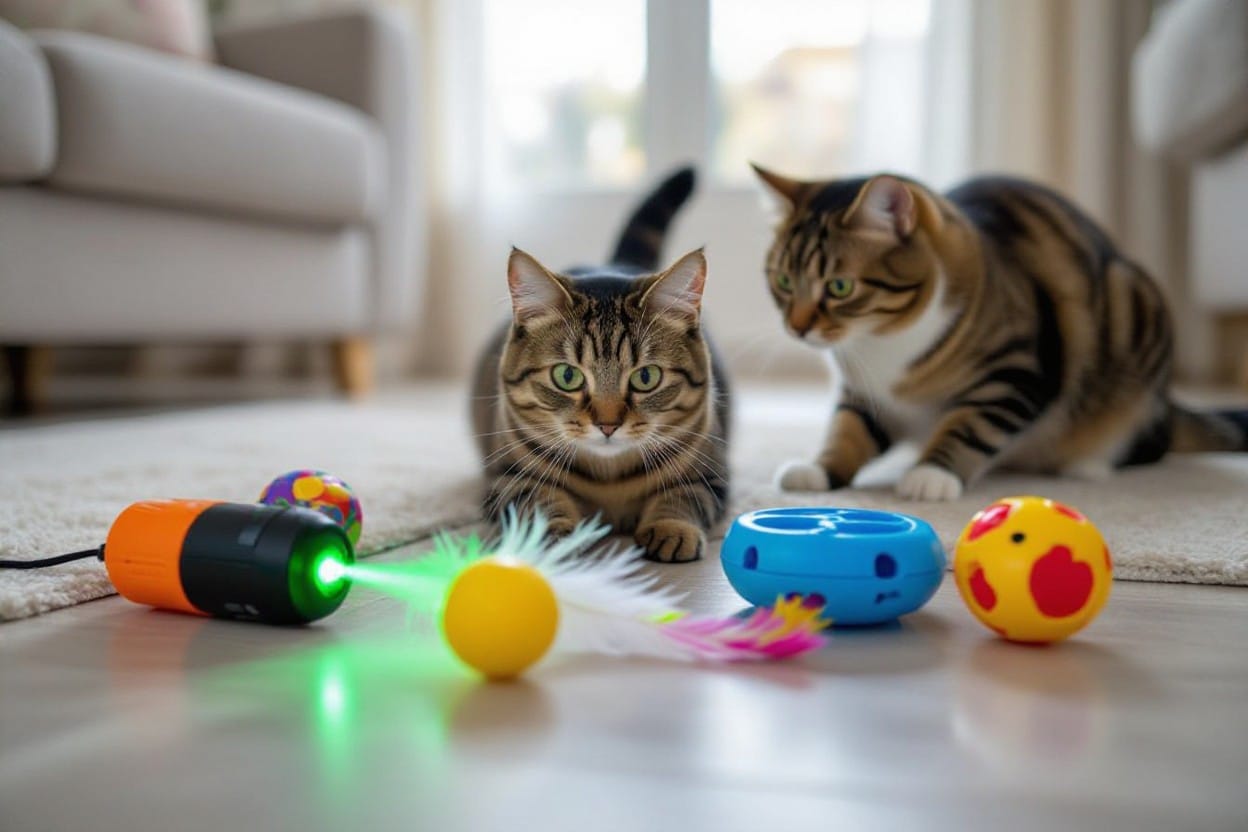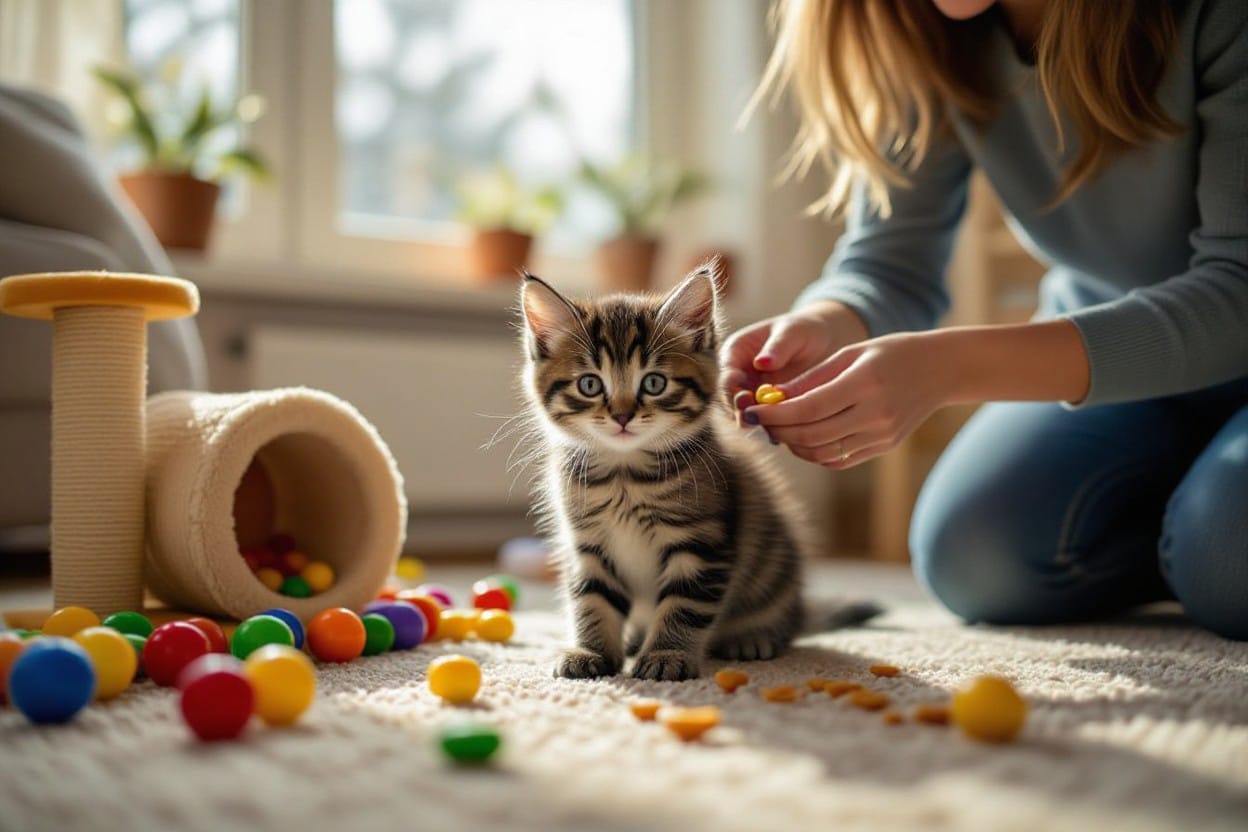You can make every room safe with this cat-proofing your home: vital tips for a safe environment guide that helps you identify hazards like toxic plants and medications, unsecured windows and screens, dangling cords, and accessible chemicals. Systematically check kitchens, bathrooms, bedrooms, and balconies, lock cabinets and secure heavy objects, remove small ingestion risks, and create safe vertical spaces so your cat thrives without danger.
Key Takeaways:
- Apply “cat-proofing your home: crucial tips for a safe environment” with a room-by-room checklist—secure medicines, cleaners, small objects, and appliances in kitchens, bathrooms, laundry rooms, and bedrooms.
- Reduce injury and escape risks by anchoring furniture, securing windows/screens and balconies, concealing cords, and removing toxic plants and accessible chemicals.
- Adopt safety systems and habits: use pet-safe products, store hazards out of reach, provide enrichment to deter risky behavior, and ensure ID/microchip plus routine inspections.
Understanding Cat Behavior and Safety Needs
Natural Curiosity and Exploration
Cats investigate by sight, sound and mouth; kittens may investigate dozens of new objects a day and adult cats still jump and climb to survey territory — they can leap 5–6 times their body length, so high shelves and curtain rods become obvious destinations. You’ll see pawing at drawers, tunneling into boxes, or drinking from cups because cats use taste and texture to learn; that same curiosity makes them prone to chewing cords, knocking over vases, and sampling houseplants.
Provide alternatives that channel exploration into safe outlets: install tall cat trees and window perches, offer puzzle feeders and rotating toys, and schedule interactive play sessions of about 10–15 minutes twice daily to burn energy. Securing cupboards with latches and hiding cables behind cord covers reduces accidental access and prevents common injuries tied to investigative behavior.
Assessing Hazards: Common Risks in the Home
Scan each room for toxins and mechanical dangers: many common houseplants (notably lilies) are highly toxic to cats, human medications and household cleaners can cause severe poisoning, and ethylene glycol (antifreeze) and certain rodenticides can be fatal even in small amounts. Mechanical risks include exposed electrical cords (electrocution/burns), strings and rubber bands (intestinal obstruction), open windows without secure screens (falls), and hot stovetops or candles that cause burns.
Turn the scan into a checklist: kitchen — secure food, medicines and trash; bathroom — lock up cosmetics and cleaning agents; laundry and garage — store detergents, antifreeze and pesticides out of reach; living areas — use cord organizers, secure blinds cords, and remove small objects like hair ties and buttons that can be ingested. Framing your efforts around cat-proofing your home: necessary tips for a safe environment helps prioritize items that most frequently cause emergency vet visits.
Prioritize fixes that eliminate the highest-risk exposures first: keep toxic plants out of the home entirely, install window screens rated for pet safety, swap candles for LED alternatives, and store all human medications in locked cabinets. Using childproof locks, covered trash bins, and closed-lid compost/food containers reduces repeated exposures that are a common source of poisoning and obstruction.
Recognizing Signs of Stress and Anxiety
Behavioral changes often signal stress: increased hiding, sudden aggression, excessive vocalization, or inappropriate elimination in the house are common indicators. You’ll notice overgrooming that creates bald patches, loss of appetite or sudden changes in sleep patterns; these signs often follow environmental changes like moves, new pets, or altered routines.
Physical and litterbox symptoms can escalate quickly: constipation, diarrhea, or urinary straining may reflect anxiety-driven issues and in some males can progress to life-threatening urinary blockage. Look for subtle shifts such as less grooming (dull coat), weight loss, or persistent pacing — these warrant earlier intervention to avoid medical complications.
Mitigate stress with evidence-backed strategies: provide one litter box per cat plus one extra, create multiple vertical and hiding spaces, maintain consistent feeding and play schedules, and consider synthetic pheromone diffusers (Feliway) to reduce tension. Monitoring behavior daily and acting on early signs with environmental adjustments or a vet consult prevents many stress-related emergencies.
Living Room Safety Measures
Managing Electrical Hazards
Run cords inside cable raceways or use split-loom tubing to prevent chewing; route cables along baseboards or behind furniture and secure them every 6–8 inches with zip ties or adhesive cord clips. Cover exposed outlets with tamper-resistant caps and mount power strips off the floor to keep plugs out of paw-reach. Chargers for phones, laptops, and lamps are common culprits—cats that chew cords risk electric shock, burns, or starting a fire.
Switch to surge-protected smart plugs for high-use devices and unplug holiday lights or decorative string lights when you’re not supervising them. If you have lamps with hanging cords, twist the cord into a loop and clip it to the lamp base or use a cord shortener; for TVs and consoles, run power and HDMI cables through wall channels or behind anchored entertainment centers to eliminate temptation.
Ensuring Secure Furniture and Decor
Anchor tall furniture—bookcases, cabinets, and dressers—to studs using anti-tip brackets and 2.5-inch wood screws or manufacturer-recommended hardware; unsecured units can top over when a cat jumps and may cause severe injury. Wall-mount flat-screen TVs or use low, secured TV stands paired with safety straps; avoid placing heavy or breakable items on top shelves that a cat might use as a launch point.
Use museum putty or removable adhesive gel under vases, picture frames, and small sculptures to prevent sliding; non-slip pads under lamp bases and heavy décor add another layer of protection. Replace open-flame candles with battery-operated LED alternatives and store glassware or collectibles inside sealed cabinets with glass doors rather than on open surfaces.
Add vertical enrichment so your cat has safe alternatives to counter-surfing and shelf-scaling: install wall-mounted cat shelves, a tall scratching post, or a stable window perch to redirect climbing behavior and reduce the chance of tipping or breaking decor items.
Assessing Plant Safety
Remove or relocate high-risk species—all lilies (Lilium and Hemerocallis), philodendron, pothos, dieffenbachia, and certain peace lilies—to an inaccessible room or discard them; ingestion of lily pollen or leaves can lead to acute kidney failure in cats. Swap toxic houseplants for cat-safe options like spider plant, Boston fern, areca palm, cat grass, or catnip and clearly label any remaining plants so you can verify toxicity before bringing new ones home.
Keep potting soil, granular fertilizers, and pesticide-treated mulch in sealed containers out of reach; small amounts of ingested fertilizer, slug bait, or insecticide can cause gastrointestinal upset, neurologic signs, or worse. Use plain, untreated soil and water-only plant care where possible, and check the ASPCA’s toxic plant database or consult your veterinarian when in doubt.
Place plants in heavy, stable outer pots or hang them from high ceilings with sturdy hardware to prevent tipping; for open-plan living rooms, consider enclosed terrariums or tall plant stands with a lip to stop curious paws from knocking pots over, and offer a designated planter of cat grass to satisfy chewing instincts.
Kitchen Safety Protocols
Identifying Appliance Dangers
Gas and electric ranges present multiple risks: open flames, hot surfaces exceeding typical oven baking temperatures (often >400°F), and reachable control knobs that a curious cat can nudge. Small appliances — toasters, slow cookers, and kettles — often have exposed cords and low profiles that invite pawing; a tipped kettle can cause severe burns and scalds within seconds.
Mitigate these hazards by using physical barriers and habit changes: place pot handles turned inward and cook on back burners when possible, install stove knob covers or a stove guard that creates a 3–4 inch deterrent zone, and unplug small appliances after use. Route cords behind appliances or use cord shorteners, and consider motion-activated pet deterrents on counters where stove or toaster access is likely.
Secure Food Storage Techniques
Certain human foods are highly toxic to cats, including chocolate, xylitol (in sugar-free gum), onions, garlic, grapes and raisins, alcohol, and caffeine. Leaving food uncovered on counters or within easy cabinet access increases the risk of ingestion and accidental poisoning; even small amounts of some substances can trigger vomiting, diarrhea, or acute kidney injury.
Lockable pantry solutions reduce risk: install magnetic or spring-latch cabinet locks on lower cupboards, store hazardous items in opaque, airtight containers on high shelves, and keep treats and specialty foods in sealed jars or a designated locked drawer. Refrigerated leftovers should be placed in clear, labeled containers so you can quickly secure them and spot any missing items.
For practical setup, use magnetic cabinet locks (typically $8–$20 per unit) on any low cabinets, place frequently used but hazardous items like xylitol-containing gums in a top-shelf bin, and adopt stackable airtight containers for dry goods to eliminate tempting odors; a motion-sensor alarm on pantry doors adds a low-cost layer of protection if you have a particularly determined jumper.
Cleaning Product Safety and Accessibility
Many cleaning agents contain ingredients that are toxic to cats: bleach, phenol-based disinfectants, pine- or oil-based cleaners, and concentrated crucial oils (tea tree, eucalyptus) can cause skin irritation, respiratory distress, or systemic toxicity if ingested or absorbed. Aerosolized sprays and residue left in mop buckets present hidden exposure routes that you might overlook.
Store all cleaners in a locked cabinet or a top shelf behind childproof latches, and never leave buckets or soaked mops within paw reach. Switch to labeled pet-safe enzymatic cleaners for organic stains and odors, rinse surfaces thoroughly after using stronger disinfectants, and keep Safety Data Sheets (SDS) or product labels accessible so you can check active ingredients quickly.
As an operational tip, keep a small checklist on the inside of a cleaning cabinet door: list which products are pet-safe, which require dilution and rinsing, and a note to keep pets out until surfaces are fully dry; this habit reduces accidental exposure and gives you a quick reference during cleaning.
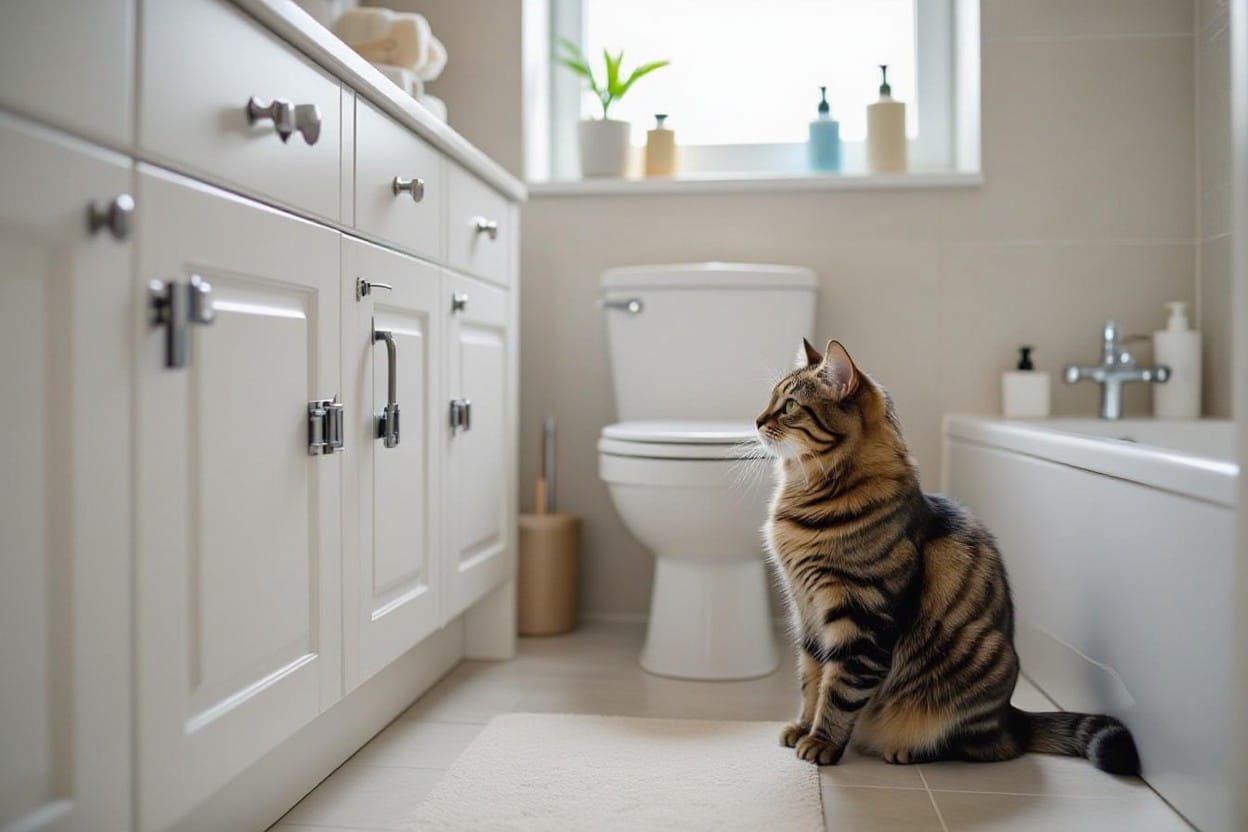
Bathroom Safety Practices
Water and Slippery Surface Hazards
Tile and porcelain floors become very slippery when wet, and a startled cat can slide into a vanity or hit a sharp edge; place low-profile, rubber-backed mats with strong suction or skid-resistant soles at the tub, shower entry, and in front of the sink to reduce slips. Look for mats rated for high traction and frequent washing—microfiber or rubber-backed options that describe skid resistance on the label are best, and replace mats once the backing shows wear or tears.
Keep towels and bathmats bunched up less often by using wall-mounted hooks or closed bins so your cat doesn’t use them as launch pads; close toilet lids and run the exhaust fan during showers to cut down on puddles and condensation that lower floor friction. You can also install a small threshold strip or anti-slip tape (adhesive strips with at least 0.6 coefficient of friction) on slippery step edges to give your cat extra grip when jumping in and out.
Secure Medicine Cabinet Access
Store all human and pet medications behind a lock or in a lockable box—even a single 325 mg acetaminophen tablet can be lethal to a 4–5 kg cat, so leaving pills on counters or in open pill organizers is too risky. Use magnetic or keyed cabinet locks, high-mounted cabinets, or a small lockbox that you bolt inside the cabinet to prevent accidental access by curious paws or kittens who can open loose doors.
Put pill bottles in their original child-resistant containers and keep dosing syringes, topical creams, and supplements sealed; scents and flavors can attract cats, and stray tablets dropped on the floor are a common cause of poisoning calls to veterinarians. Post a small laminated list inside the cabinet with emergency numbers—your regular vet and the ASPCA Animal Poison Control Center at 888-426-4435—so you can act fast if ingestion occurs.
For multi-cat households, store any medicated ear or skin treatments in a separate locked pouch, and schedule a weekly check to ensure no pills have fallen behind cabinets or under appliances; a flashlight inspection twice a month dramatically reduces the chance of hidden hazards.
Managing Chemical Substances
Household chemicals like bleach, drain cleaner, and toilet bowl tablets contain caustic agents that can burn skin and mucous membranes; keep them in a locked cabinet or high shelf and in their original, labeled containers to avoid accidental mixing or ingestion. Antifreeze (ethylene glycol) is especially dangerous because of its sweet taste—as little as a teaspoon can be toxic to small cats—so swap to propylene glycol formulas labeled pet-safe or use gel packs designed to deter animal access wherever possible.
Essential oils and concentrated fragranced products pose inhalation and topical risks—tea tree (melaleuca), eucalyptus, and peppermint have caused tremors and ataxia in cats after small exposures—so avoid diffusing these in shared spaces or store bottles in sealed, locked cabinets. Choose enzyme-based or vinegar-and-water cleaners for routine bathroom cleaning; they work on organic stains and are far less hazardous if your cat sniffs or walks through a damp surface.
After using any chemical, wipe down surfaces and ventilate the room for at least 15–20 minutes to reduce residue and fumes, and label a disaster kit with the location of safety data sheets (SDS) for products you keep—this speeds up treatment if your vet or poison control asks for specific ingredient information.
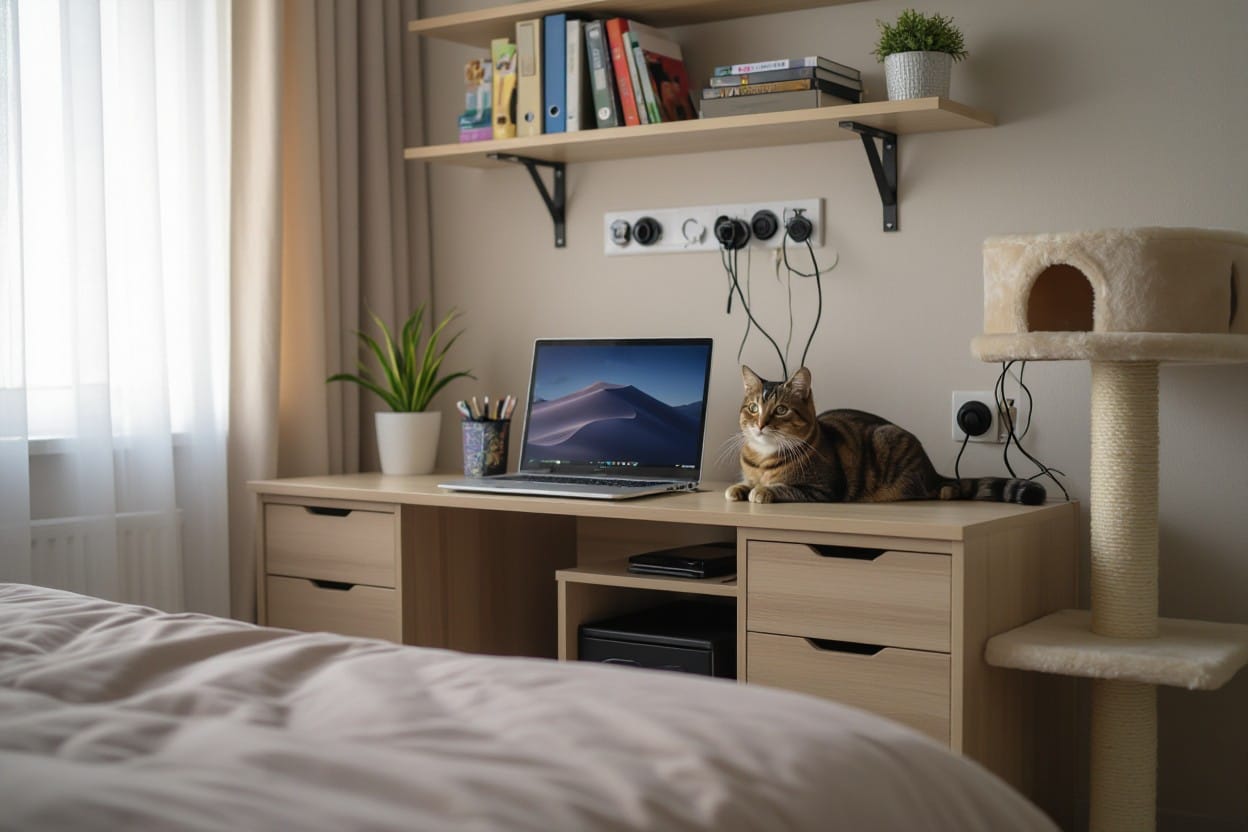
Bedroom and Home Office Precautions
Cord Management Solutions
Keep exposed charging cables and power strips out of reach by routing cords along walls with adhesive cable raceways or 3/8-inch adhesive clips spaced every 6–8 inches; that spacing prevents sagging loops cats can bat at. Use spiral cable wraps or braided, chew-resistant sleeves for clusters of cords and stash excess length in a cord box or a Velcro-tied coil to eliminate tempting dangling loops.
Anchor window-blind cords with tie-down cleats or install cordless window coverings to remove a major strangulation and entanglement hazard. Consider replacing cheap frayed chargers with molded, reinforced cables or placing electronics on raised shelves; low, loose or frayed cords are the highest immediate danger for electrocution and chewing injuries.
Protecting Small Items and Jewelry
Store rings, earring backs and loose beads in sealed containers or a lockable jewelry drawer—items under 2.5 cm (1 inch) are easiest for kittens to swallow and can cause intestinal blockage. Use clear, stackable plastic bins for costume jewelry and label them so you can keep frequently used pieces in a high, cat-proof location like a closet shelf or a closed dresser drawer.
Display cases with glass doors or weighted bases make good solutions for sentimental trinkets you want visible but safe; mounting a shallow, wall-mounted shadow box high above cat jump paths prevents accidental knocks while keeping pieces accessible to you.
Anchor small decorative items that must sit on surfaces with a dab of museum putty or silicone adhesive (non-permanent options allow removal without damage), and avoid leaving loose beads, hair ties or safety pins on bedside tables where a curious paw can send them under furniture or into the litterbox.
Maintaining Safe Office Supplies
Keep sharp tools—staplers, scissors, X-Acto knives—in closed drawers or magnetic holders; use retractable blades and lockable storage for utility knives. Store paperclips, thumbtacks and rubber bands in lidded or magnetic containers to prevent ingestion and scattering, and secure home shredders inside a cabinet or unplug and lock them when not in use to avoid paw access.
Label and cap all glues, solvents and inks, and swap solvent-based adhesives for water-based alternatives where possible; button batteries and toner cartridges pose chemical and ingestion hazards, so store them in sealed, high cabinets or metal tins out of reach.
Bolt bulky items like printers and paper stacks to the desk surface or place them on low, enclosed shelving to prevent tipping during a leap; adding drawer stops and using an anti-tip bracket on filing cabinets reduces the risk of a heavy fall that could injure your cat or damage equipment while you’re cat-proofing your home: vital tips for a safe environment.
Laundry Room Safety Considerations
Machine and Appliance Safeguards
Front-loading washers and dryers create an attractive, warm hiding spot for cats; close the door and run a quick drum check before every cycle. Many modern machines include child locks and automatic door locks—engage these features and keep laundry-room doors closed to prevent access. Unattended dryers can reach temperatures that cause severe burns, so never leave a cycle running if your cat can enter the room.
Clean the lint trap after each dryer load and schedule a professional vent inspection yearly to reduce fire risk and remove accumulated cat hair. Position machines so vents and cords are inaccessible; a loose power cord or a dangling hose can be pulled or chewed, leading to electrical hazards or sudden appliance movement that could injure a pet.
Storing Detergents and Cleaning Products
Store laundry pods, concentrated detergents, bleach, and stain removers in a locked cabinet or high shelf—laundry pods are especially dangerous, as one pod can dissolve and release concentrated chemicals if mouthed by a cat. Choose opaque, childproof containers and avoid leaving open bottles on countertops where curious paws can tip them over.
Keep a small spill kit (absorbent cloths and gloves) nearby and label containers with clear hazard tags; if a spill occurs, isolate the area until cleaned and ventilated to prevent inhalation or paw contamination. You can also use cabinet locks rated for pet safety and place deterrent mats (textured, scaring surfaces) in front of storage areas if your cat is persistent.
Consider switching to pet-safer formulations where possible—enzyme-based stain removers and low-fragrance detergents reduce respiratory irritation—but never assume any product is non-toxic; consult the product’s safety data sheet and store all chemicals in sealed containers at least 4–5 feet above floor level or behind a lock to eliminate accidental exposure.
Iron and Heat Source Management
Leave an iron plugged in only when supervised and set it on a stable, heat-resistant rest; many models include an auto-shutoff that triggers after about 8–10 minutes upright or 30–60 seconds if tipped, so verify those settings when replacing an older iron. Store the iron completely cooled and unplugged in a high cabinet; cats commonly jump onto ironing boards and can knock hot appliances onto themselves or others.
Secure iron cords out of reach and avoid running cords across furniture where a cat can tug or chew them—braided cord covers and cord shorteners reduce the risk of entanglement or appliance pull-downs. Steam generators and garment steamers emit very hot vapor that can cause deep burns in seconds, so keep your cat out of the room while steaming.
When using any heat appliance, designate a cooled staging area and allow a minimum of 15–20 minutes before storing to ensure no residual heat remains; combine that practice with a locked cabinet or high shelf to remove temptation and eliminate the risk of thermal injuries from accidental contact.
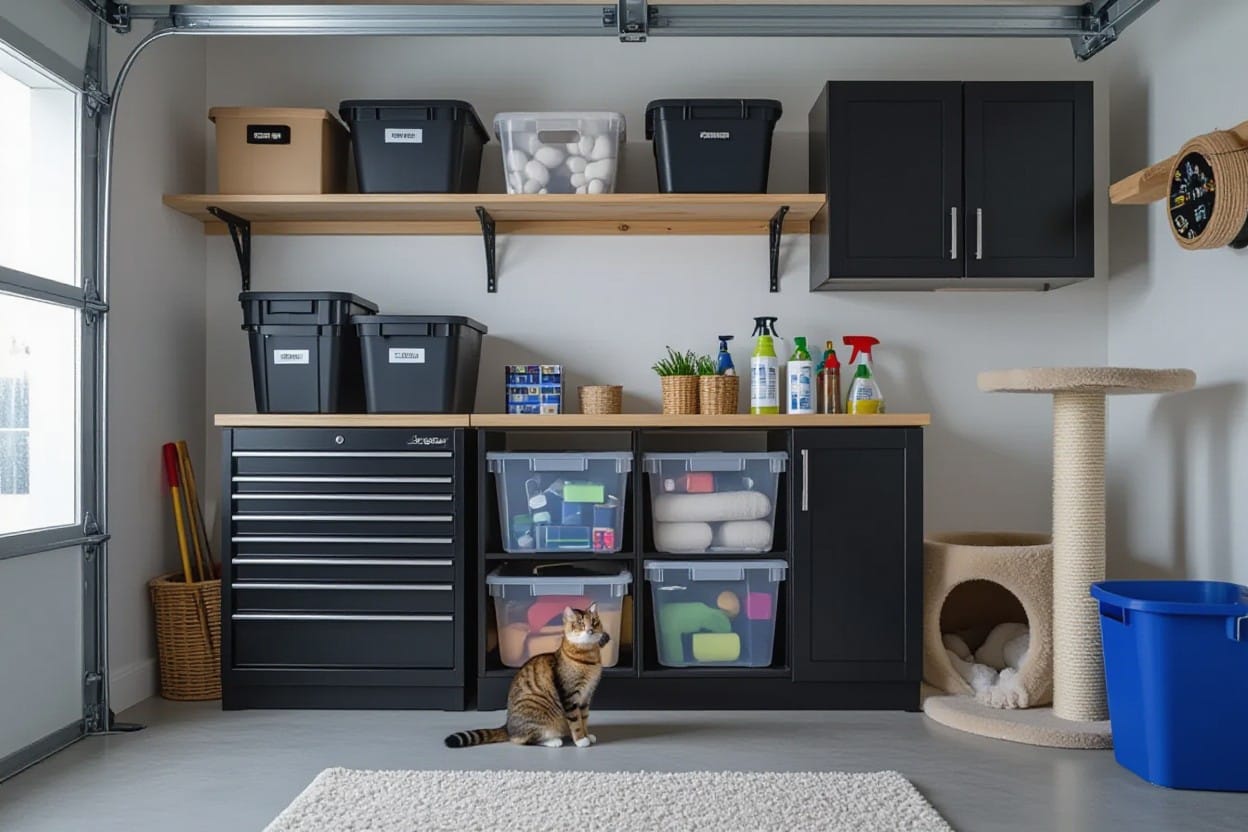
Garage and Storage Space Safety
Securing Chemical Products
Store antifreeze, pesticides, paints, solvents and rodenticides in their original containers inside a locked cabinet at least 4 feet (1.2 m) above the floor, using secondary containment (plastic tubs with lids) to stop leaks. Ethylene glycol in antifreeze is highly toxic to cats; even small amounts can be fatal, so keep all spill-prone liquids in sealed, labeled containers and place the cabinet on a drip tray or shelf with a raised lip.
Keep a printed copy of Safety Data Sheets (SDS) and emergency numbers near the garage entry—ASPCA Animal Poison Control: 888-426-4435 and Pet Poison Helpline: 855-764-7661. Use childproof/latching cabinet hardware rated for garage use, store pesticides in a locked metal cabinet, and check storage every month for compromised seals or corroded containers that could leak hazardous fumes or liquids.
Preventing Access to Sharp Tools and Power Tools
Place hand tools, saw blades, chisels and box cutters inside a locked tool chest or on a pegboard mounted above reach, with sharp edges sheathed—store at least 4 feet (1.2 m) above the floor and use locking peg hooks or cabinet latches. Leave power tools unplugged, remove batteries from cordless units, and fit guards and blade covers on saws and grinders; a table saw with a keyed switch or lockable disconnect reduces the chance a curious cat triggers the machine.
Keep fasteners and scrap metal in sealed, labeled bins to prevent cats from pawing through loose nails or screws; magnetized trays work for workbenches but store them inside closed drawers overnight. Maintain a weekly floor sweep—use a shop vacuum to pick up tiny metal pieces and spine-like shards that can puncture paws or be ingested.
Install a padlock or keyed latch on workshop doors and consider a heavy-duty metal toolbox with a keyed lock for frequently used sharp tools; adding a motion-activated light over the workbench discourages nocturnal exploration and makes it easier to spot hazards before you enter.
Ensuring Car Safety for Curious Cats
Check under the vehicle, wheel wells and engine bay before starting the car—open the hood and visually inspect, shine a flashlight into tight spaces and tap the hood twice, then wait 10 seconds to allow any hidden cat time to move. Cold weather increases risk as engine compartments warm quickly; many vets see a seasonal rise in burn and crush injuries to cats during winter months.
Keep the garage closed and locked when not in use, and avoid using remote start if the vehicle could contain an animal. Provide an alternative warm shelter outdoors (insulated cat box or heated pad) so cats are less likely to seek out engines for warmth, and use motion-activated deterrents or cameras to monitor vehicle areas at night.
Engine components often exceed 100°C (212°F)</strong) after running, so a cat trapped in the engine bay can suffer severe burns or fatal injuries quickly; making a habit of a visual and tactile check before starting the engine is the most effective single-step you can take to protect them.
Outdoor Space Safety
Fencing and Enclosures for Cats
Install a fence at least 6 feet high and add an outward-angled top or roller system to deter climbing — many agile cats can scale a plain 6-foot barrier. Attach 1-inch hardware cloth or welded wire along the base extending 6–12 inches outward or bury it 6 inches to prevent digging escape routes.
Consider a purpose-built catio or modular enclosure: a 4 x 6 ft catio with multiple vertical levels, scratching posts, and protected entry reduces wildlife encounters and traffic risks while giving your cat safe outdoor time. Avoid barbed wire and electrified fencing; they can cause severe injury and legal liability.
Assessing Plant Safety in the Garden
Scan your garden for high-risk species: true lilies (Lilium spp.) can cause acute kidney failure after ingesting any part, sago palm seeds may induce liver failure with as little as one seed, and oleander, azaleas, rhododendrons produce cardiotoxic effects. Houseplants like dieffenbachia and philodendron contain calcium oxalate crystals that provoke severe oral irritation and drooling if chewed.
Replace or relocate hazardous plants to out-of-reach hanging baskets, use heavy terracotta pots elevated on secure stands, and choose safer species such as catnip, cat grass (wheatgrass), basil, rosemary, or thyme to give your cat supervised nibbling options.
Perform a quick plant audit: label each plant with its common and Latin names, consult the ASPCA online toxic plant list, and remove mulch or fertilizers containing pesticides or rodenticides; substitute iron phosphate slug controls and organic compost to reduce poisoning risk.
Managing Hazards in Outdoor Areas
Store fertilizers, pesticides, fuels, and solvents in locked cabinets or high shelves; ethylene glycol (antifreeze) is highly attractive due to its sweet taste and can be lethal in small quantities, so collect spills immediately and use pet-safe alternatives. Keep compost bins secured and avoid granular rodenticides—those compounds can cause delayed, fatal bleeding or organ failure if ingested.
Protect water features and pools with secure fencing, ramps, or netting; shallow escape ledges should be added to ponds and steep-sided features to prevent accidental drowning. For free-roaming cats, use supervised outings, harness walks with a 4–6 ft leash, or timed outdoor sessions in an enclosed area to reduce traffic and predator exposure.
Create an outdoor safety checklist you run through monthly: inspect fences for gaps, check for new toxic plants, sweep for pesticide granules, verify pool covers and ramps, and keep emergency numbers (local vet, ASPCA 888-426-4435, Pet Poison Helpline 855-764-7661) and a carrier accessible for rapid response.
Cat-Proofing for Kittens
Size-Specific Hazards and Vulnerabilities
Small gaps, loose laundry, and open appliance doors represent real dangers because kittens often weigh only 1–2 pounds by 8 weeks and can squeeze into spaces adults cannot. You should block access to dryer and washer drums, cover floor-level vents, and seal gaps under furniture and behind appliances where a 2–3 inch opening can trap a kitten. Tiny objects—rubber bands, hair ties, coins, small children’s toy parts and button batteries—pose immediate choking and ingestion risks; keep these items in closed drawers or high storage.
Low-hanging cords, blinds, and string toys are especially hazardous: kittens will chew and climb them, risking electrocution or strangulation. Use cord protectors, clip cords up out of reach, and replace looped blind cords with short, secured alternatives. Houseplants known to be toxic—such as lilies, philodendron, and pothos—should be removed or placed where a determined climber can’t reach them, and any open-access chemicals or medications must be stored in locked cabinets.
Developmental Stages and Supervision
Neonatal to 4 weeks: kittens are fragile, sleep a lot, and have limited mobility, so you should confine them to a warm, draft-free nesting area and limit handling to short, supervised sessions. At 4–8 weeks they begin exploring and teething; expect increased mouthing and climbing. Provide safe chew options and watch closely around kitchens, stairs, and places with hot surfaces or open flames.
From 2 to 6 months the play drive peaks—burst activity every few hours with rapid learning of what’s climbable. Supervise interactions with other pets and young children, rotate enrichment to reduce destructive behavior, and schedule short play sessions (5–10 minutes) multiple times per day to channel predatory instincts. Vaccination and deworming typically start at 6–8 weeks, so plan veterinary visits before expanding unsupervised access.
When you introduce new freedoms, use gradual trials: allow solo access to one new room for 15–30 minutes while observing, then extend time if the kitten navigates hazards safely. That staged approach helps you identify problem spots—loose screws on furniture, unsecured windows, or tempting trash bins—before you leave the kitten unsupervised for long stretches.
Environmental Adaptations as They Grow
Start with a single kitten-proofed room for the first 7–14 days, then expand living space as the kitten matures and demonstrates safe behavior. Install a low-entry litter box and keep one litter box per cat plus one extra in the long term; clean litter boxes daily to prevent avoidance and accidents. Provide stable vertical options—scratching posts and a cat tree 4–6 feet high—to satisfy climbing instincts and keep fragile surfaces and breakables out of reach.
As your kitten approaches 4–6 months, swap fragile toys for sturdier, durable options and secure cabinets that hold cleaning supplies, antifreeze, and human medications because adolescents chew and counter-surf more frequently. Reinforce window screens or install pet-safe window guards since screens are not load-bearing and can fail under a playful jump; consider limiting open-window access until the kitten reliably responds to commands or is microchipped and indoors-only.
Adjust furniture and access points incrementally: raise breakables, add magnetic or childproof latches to low cabinets, and use pet gates to block staircases at night. Increasing freedom based on demonstrated safe behavior reduces injury risk and aligns the environment with the kitten’s growing size, curiosity, and energy levels.
Senior Cat Accommodations
Addressing Mobility Challenges
Install low-angle ramps and short step modules to your cat’s favorite jump spots so you reduce the need for high leaps; aim for steps no taller than 2–3 inches or ramps with gentle inclines to protect arthritic joints. Replace high-sided litter boxes with low-entry models (side openings ≤3–4 inches) and position one on each level of the home so your cat doesn’t have to climb stairs multiple times a day.
Cover slippery floors with non-slip runners and secure area rugs to create stable pathways at least 18 inches wide to the litter box, food, and sleeping areas. Keep pathways free of furniture legs and cords, and provide orthopedic beds with 2–3 inches of memory foam or a low-heat pad to reduce pressure on sore joints and encourage restful sleep.
Providing a Comforting Living Environment
Offer multiple shallow, warm resting options near windows and family activity so your cat can observe without exerting itself; consider pheromone diffusers such as Feliway and maintain a slightly warmer ambient temperature to ease stiffness. Swap tall cat trees for platforms with wide, stable steps and place scratching pads on the floor to keep grooming and stretching comfortable.
Adapt enrichment to lower-energy engagement: use puzzle feeders that require minimal pawing, provide short interactive play sessions focused on gentle movement, and groom more frequently to compensate for reduced self-care. Keep feeding and cleaning times consistent to reduce stress and preserve appetite.
Increase comfort further by consolidating vitals—food, water, litter—into a single accessible zone if your home has stairs, and use motion-activated night lights to help nocturnal trips; these small changes can reduce anxiety and nighttime falls.
Medical and Health Considerations
Schedule wellness exams every 6 months and run baseline diagnostics (CBC, chemistry panel, urinalysis, and thyroid screen) at least annually; chronic kidney disease affects roughly 30% of cats over 10, so monitoring creatinine, SDMA, and urine specific gravity detects issues early. Discuss validated pain assessment tools with your vet and consider prescribed analgesics—gabapentin, dose-adjusted NSAIDs like meloxicam, or other options—never giving human OTC drugs such as acetaminophen or ibuprofen.
Make medication easier by using pill pockets, compounded flavored formulations, transdermal gels where appropriate, or automated dispensers, and set phone reminders or a weekly pill organizer to maintain strict dosing schedules. Track weight and appetite, as a loss of 5–10% body weight in a month warrants immediate veterinary follow-up.
Log litter-box frequency, water intake, mobility changes, and grooming behavior on a simple checklist or app so you can spot subtle declines early; sudden lethargy, rapid weight loss, or breathing difficulty are red flags that need urgent attention.
Emergency Preparedness and First Aid
Assembling a Comprehensive First Aid Kit
Stock a kit tailored for feline needs: sterile gauze pads, self-adherent bandage (Vet Wrap), adhesive tape, small scissors, tweezers, disposable gloves, and a digital rectal thermometer (cat normal temp 100.5–102.5°F). Include sterile saline for eye/skin rinses, an antiseptic solution such as chlorhexidine, an antibiotic ointment for superficial wounds, and styptic powder for minor bleeding. Keep an oral syringe, small flashlight, emergency blanket, and a soft carrier with a familiar towel for safe transport.
Store copies of your cat’s medical records, vaccination history, current medications with dosages, microchip number, and a recent photo in the kit (physical and digital). Replace perishable items every 6–12 months and verify the thermometer batteries quarterly. Add a note that acetaminophen and ibuprofen are toxic to cats and that you should contact a veterinary professional or poison hotline before attempting at-home chemical treatments like inducing vomiting.
Planning for Poison Control and Emergencies
Identify the most likely household hazards and keep quick-reference info visible: a list of common toxins (for example, lilies — any exposure can cause acute kidney failure in cats, ethylene glycol/antifreeze, rodenticides, certain human medications, and some houseplants like sago palm). Save emergency numbers where you can access them quickly: your primary vet, the nearest 24/7 emergency veterinary hospital, ASPCA Animal Poison Control 1-888-426-4435, and Pet Poison Helpline 1-855-764-7661 (US).
When you suspect poisoning, collect a sample of the substance, its container or packaging, and any vomit or hair/feces in a sealed bag to bring to the clinic; this often speeds diagnosis and treatment. Post clear instructions near your phone and in your first-aid kit that tell you to call poison control first for guidance on whether immediate transport or on-site measures are needed.
Keep a small, labeled evidence bag and a notepad in your kit so you can record the time of exposure, observed symptoms, and any at-home actions taken; this timeline can change treatment decisions—for example, ethylene glycol is most treatable if antidote is given within 8–12 hours of ingestion.
Establishing Emergency Contact Protocols
Compile a laminated emergency card with primary vet, emergency clinic, poison hotlines, your work and neighbor contacts, and your microchip company; place copies in the kit, on your fridge, and saved in your phone under “ICE—pet.” Designate at least one out-of-area contact who can coordinate care if you’re unavailable and make sure that person has house keys and carrier access. Aim for a minimum of a 72-hour evacuation kit (food, water, meds, litter, scooper) per cat during an evacuation.
Run a simple drill twice a year so you and household members can move a cat into a carrier within 3–5 minutes; note which exits are fastest and where carriers are stored. Keep a list of alternate emergency clinics within a 30–60 mile radius in case local facilities are overwhelmed after a disaster.
Use a brief checklist on the laminated card: first call poison hotline (if ingestion suspected), then call your vet or emergency clinic, gather sample/pack carrier, and proceed immediately; having that one-line protocol reduces panic and shortens response time in real incidents.
Downloadable Resources for Cat Proofing
Room-by-Room Safety Checklists
Download printable checklists for each area of your home—kitchen, bathroom, laundry, bedroom, living room, balcony, garage, and yard—with specific, actionable items. The kitchen checklist has a 12-point scan (secure cabinets with magnetic locks, store all foods that are toxic to cats like onions, garlic, grapes, and chocolate in high or locked cabinets, and use covered trash cans); the bathroom and laundry lists each include 8 critical checks (lock up cleaners and medications, secure dryer doors to prevent entrapment, and remove open containers of bleach or fabric softener).
Use the monthly inspection grid to track fixes and note the date of the last update; teams that run a room sweep every 30 days report fewer emergency vet visits. Each checklist contains room-specific photos and quick fixes—examples: clamp loose curtain cords behind a baseboard, replace Venetian blinds with cordless window coverings, and anchor tall furniture to walls to prevent tipping during play.
Emergency Contact Cards
Print wallet-sized, foldable cards that list your primary vet, nearest 24/7 emergency clinic, and poison hotlines—include the ASPCA Animal Poison Control: 888-426-4435 and local animal control numbers. Cards come preformatted with fields for your cat’s name, microchip number, medications, allergies, and a short-action checklist (CPR basics, do-not-induce-vomit list) so anyone can act quickly.
Cards are available in PDF and editable Word formats so you can personalize them and laminate for durability; include a QR code that links to a cloud-based medical record and your microchip registration to speed triage at emergency clinics. You can also choose bilingual templates; clinics in multi-lingual areas saw a 25% faster intake time when owners provided QR-linked records.
Keep a card inside your carrier, attach one to the fridge, and give copies to sitters and neighbors; stickers sized for carriers and keychains for your own keys are included so the information travels with you during evacuation or boarding.
Guide to Cat-Safe Products
Access a vetted list of recommended products organized by room and function: pet-proof trash cans (examples include step-free locking lids), cordless blinds, secured plant stands for cat-safe plants like cat grass and spider plants, breakaway collars with ID tags, and enzyme-based, non-toxic cleaners. The guide highlights the top 12 product picks, notes price ranges ($15–$200), and summarizes user ratings and vet endorsements.
Each product entry explains why it reduces common risks—e.g., motion-sensor trash lids cut access to rotting food that causes GI emergencies, and cordless blinds eliminate strangulation hazards listed in multiple vet-safety reports. The guide also flags items to avoid, such as toys with small batteries or loose strings, and suggests durable alternatives that withstand chewing and rough play.
Criteria for inclusion are transparent: third-party safety tests, at least 4.2/5 average customer rating across 500+ reviews, and positive veterinarian feedback; the resource also links to studies on household toxin exposures and provides replacement timelines (for example, scratchers often need replacing every 12–18 months depending on wear).
Community Engagement and Support
Sharing Success Stories and Tips
You can amplify practical fixes by posting before-and-after photos, short how-to videos, and brief case summaries in local groups; one neighborhood page that encouraged step-by-step posts saw a jump in engagement and actionable feedback within two weeks. Highlighted examples — like swapping dangling blinds for cordless alternatives, installing window screens, and securing houseplants — help others visualize changes and reduce repeat hazards, particularly for curious kittens and senior cats with limited mobility.
Use a simple template for submissions: what the hazard was, which cat-proofing your home: crucial tips for a safe environment change you made, time and cost, and the outcome.
- cat-proofing your home: crucial tips for a safe environment — before/after case studies
- window and balcony safety fixes
- toxic plant identification and removal
- cord and curtain management solutions
Recognizing contributors with shout-outs or a monthly “Cat-Safe Home” feature motivates wider adoption.
Organizing Local Cat Safety Workshops
You can run a 60–90 minute workshop at a community center or shelter covering emergency first aid (how to safely remove foreign objects), household hazard audits, and simple DIY fixes like anchoring tall furniture and fitting screens. Aim for 15–40 attendees per session, invite a local veterinarian for a 15-minute Q&A, and demonstrate three hands-on projects: secure cord covers, non-toxic plant swaps, and making a cat-safe balcony. Budget between $0–$200 for materials; partner discounts from pet stores or shelters often cut costs by 30–50%.
Promote workshops through flyers at vets, targeted Nextdoor posts, and a short RSVP form to track turnout; provide printed checklists and a one-page emergency contact card for each attendee to complete. After the workshop, collect short surveys and share a resource pack (plant lists, tool links, step-by-step photos) by email so attendees can implement fixes within 2–4 weeks — a follow-up can increase adoption rates significantly.
More info: prepare a 60-minute agenda (10 min intro, 25 min demos, 15 min vet Q&A, 10 min hands-on practice) and a materials list (zip ties, Velcro, adhesive cord covers, sample non-toxic plants, small tool kits). Arrange a volunteer to photograph demonstrations and curate a post-event PDF to distribute; offering a low-cost “tool kit” for purchase at the door often raises funds to run future sessions.
Building a Network of Cat Owners
You can form a neighborhood network using a dedicated Facebook group, a pinned Nextdoor thread, or a simple email list; aim for an initial core of 8–12 active members to coordinate monthly check-ins, hazard maps, and emergency contact sharing. Encourage members to report local risks (e.g., recently spotted toxic plant species, loose gutters, or open rooftop access) and keep a shared map of problem spots — one community reduced balcony falls by coordinating window-screen installs for 20 residences in a single season.
Organize quarterly meetups that combine short presentations with swap tables for pet-safe supplies and group-buy opportunities for screens or harnesses to reduce cost by up to 40%. Maintain an easily accessible shared document with vet contacts, poison-control numbers, and a template for temporary foster or emergency care; you can also set up a rotating skills roster (first aiders, DIY fixers, transporters) to respond quickly to incidents.
More info: start by creating a one-page welcome packet (mission, communication rules, emergency procedures) and schedule the first meeting within 2–3 weeks of recruitment. Use simple tools — Google Sheets for contacts, a Slack or WhatsApp group for rapid alerts, and a public calendar for events — to keep coordination low-friction and actionable.
To wrap up
Presently you can consolidate the room-by-room approach into a practical plan that makes cat-proofing your home: important tips for a safe environment actionable. Start by prioritizing hazards in each space—securing cords and blinds, locking up chemicals and medicines, verifying window and balcony safety, and substituting toxic plants and cleaners with pet-safe alternatives—so your home becomes consistently safer for your cat.
Implement the checklist, perform regular inspections, and adjust as your cat’s behavior or household items change; you should also train family members to follow the same protocols and use containment tools, safe toys, and habitat enrichment to reduce risk. With these steps in place, you will minimize emergency visits and create a stable, secure living environment that supports your cat’s health and wellbeing.
FAQ
Q: What does “cat-proofing your home: imperative tips for a safe environment” mean and how do I create a room-by-room checklist?
A: It means systematically removing or securing hazards in each room to prevent injury, poisoning, escape and destructive behavior. Start with a walkthrough and list hazards per room: toxic foods and plants, unsecured cords, open windows/balconies, chemicals, small objects, unstable furniture and accessible appliances. Prioritize high-risk areas (kitchen, laundry, balcony), assign fixes (cabinet locks, cord covers, window screens, anchored furniture), add enrichment (scratching posts, perches, toys) and set a schedule to re-check after changes like new furniture or guests.
Q: How do I cat-proof the kitchen to stop accidents and poisoning?
A: Secure trash with lids or locks; keep countertops clear of small items, bones, and foods toxic to cats (onions, garlic, grapes, chocolate, xylitol). Use childproof latches on under-sink cabinets containing cleaners, lock the dishwasher and oven when not in use, and fit stove knob covers or remove knob access to prevent accidental burns. Store knives and breakables out of reach, turn pot handles inward, and install cord-shortening devices so appliances’ cords can’t be chewed or pulled.
Q: What safety steps should I take in living rooms and bedrooms?
A: Anchor TVs and tall furniture to prevent tipping; conceal power cords with covers or cord wraps; remove or secure small objects (rubber bands, jewelry, hair ties) that cause choking; replace open-flame candles with flameless versions; keep houseplants that are toxic to cats out of reach or replace them with pet-safe varieties; secure windows with sturdy screens or restrictors; provide vertical spaces (cat trees, shelves) and scratching posts to reduce risky climbing.
Q: Which hazards are most important in bathrooms, laundry rooms and garages, and how do I mitigate them?
A: Keep all detergents, bleach, antifreeze, and medications in closed cabinets or locked containers; never leave toilet lids open; check washer and dryer drums before use to prevent entrapment; store pesticides, rodent bait and automotive fluids in high or locked storage; cover drains and vents, and keep toilets, trash bins and small cleaning tools inaccessible. In garages, secure tools and garden chemicals and block gaps that allow cats to slip into vehicles or crawlspaces.
Q: How can I make windows, balconies and outdoor access safe to prevent falls and escapes?
A: Fit screens with pet-safe, heavy-duty mesh or install window restrictors that allow fresh air but prevent cats from pushing through. For balconies, install Plexiglas panels or secure netting rated for pets and anchor it properly. Supervise outdoor time, use enclosures like catios or leash harness training, microchip and use a breakaway collar with ID, and seal gaps around doors and fences so cats cannot slip under or through. Check outdoor plants for toxicity and remove or fence them off.
